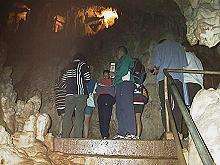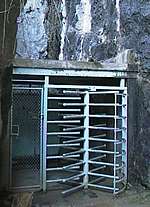8b. Management: Caves
Cave Management
The NSW National Parks and Wildlife Service manages caves at Yarrangobilly
according to the following system.
 Category
1. Public Access: Open to the public and have been developed as
public inspection caves either with a ranger or as self-guided.
Category
1. Public Access: Open to the public and have been developed as
public inspection caves either with a ranger or as self-guided.
Category 2.1 Special Purpose: Caves are managed to keep them as unmodified as possible consistent with some recreational use. Two caves have been set aside at Yarrangobilly as scientific reference caves to protect their faunal communities. Access to these will be by scientific researches holding NPWS Scientific Consents. Other caves will only be entered in the company of NPWS staff. Levels of visits are be closely monitored.
Category 2.2. Outstanding Natural Value: caves are subject to limitations on numbers and frequency of visits but not as strict as 2.1 caves. Parts of category 2.2 caves may be classified as 2.1.
Category 2.3 Dangerous: no caves at Yarrangobilly have been classified as 2.3. but several entrances to the Glory Holes caves have been classified as 2.3 to avoid dangers to tourists from cavers above.
Category 3.1 Wild Caves: there are about 120 wild caves at Yarrangobilly which require permits from the NSW National Parks and Wildlife Service to enter.
Category 3.2 Unclassified Caves: closed to access until classified.
 Plan
of Management, Kosciuszko National Park (Yarrangobilly Management
Unit)
Plan
of Management, Kosciuszko National Park (Yarrangobilly Management
Unit)
Objectives:
- protect the cave systems from disturbance;
- protect the cave and stream biota and special plant communities;
- allowing public access for recreation (tourism).
 Specific
Cave Management practices at Yarrangobilly include:
Specific
Cave Management practices at Yarrangobilly include:
- limiting tourist access to only a few caves;
- restricting public use to guided tours except for one self-guided cave;
- educating the public on cave fragility;
- only accredited caving groups, normally members of the Australian Speleological Federation, will be permitted to go caving other than at public access caves and only then with written permission;
- all groups holding permits must abide by the Codes of Ethics, Safety and Minimal Impact of the Australian Speleological Federation;
- the use of caves for toileting, smoking or carbide lamps is forbidden;
- cavers should follow a single pathway through caves to minimise human impact;
- muddy shoes and clothing must be removed in delicate areas to leave the passage mud free;
- camping or lighting fires near cave entrances is not permitted;
- the maximum number of cavers on any one trip is 12 and the minimum 3. Not more than one third can be inexperienced;
- each trip is to be undertaken by a fully experienced leader who is responsible for safety and conduct of the group.
Identifying the carrying capacity, or how many visitors a cave can take over a period of time before it suffers unacceptable levels of damage, is important but very difficult to do. Each cave needs to be assessed on its own merits and for safety or the protection of very fragile or rare formations visitor numbers may be restricted to 10 or less.
The NPWS has a dilemma in that it must protect the caves but at the same time allowing public access to this extremely fragile ecosystem. It is an ecosystem where people visitation is very concentrated in the one confined space, the cave. In other ecosystems visitor impact is spread over a larger area. Yarrangobilly’s visitation pattern is also very concentrated in time with over 25% of visitation occurring over the Christmas and Easter breaks.